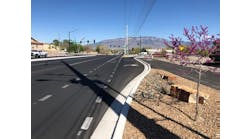Moving water may be an ancient practice, but that did not keep bright engineering minds from developing a more efficient way to do it. Balancing an aggressive, stormwater pipeline design concept with a conservative approach to prove its performance, the result was a new engineered stormwater system.
It is a familiar scene outside of shopping centers and office plazas nationwide during construction. Still unpaved, the parking lot at a Chicago-area grocery store chain was covered with crushed stone while 72,000-pound ready-mix concrete trucks and earth-moving equipment finished constructing the curbs and parking lot. What went unnoticed by most at this Jewel-Osco in Elmhurst, Ill., was Jim Goddard, the chief engineer for Advanced Drainage Systems, Inc. (ADS), crawling through the 42?-diameter N-12 HDPE pipes that make up the stormwater drainage system.
He was inspecting the new design to make sure it did not move. This detention/retention system replaces a traditional corrugated steel underground system. It also features a lower cost and a smaller footprint.
The Motivation
According to the Environmental Protection Agency (EPA), the number one cause of water pollution in the United States is paving over earth. As new or renovated commercial and residential developments are built in cities and suburbs, officials must have a plan to control stormwater quality and quantity.
The expanding city of Elmhurst is no exception. When retail centers and other commercial property owners construct or redevelop a site, Elmhurst officials require strict compliance with current storm water codes. Most commercial developments in Elmhurst must comply with an ordinance that states the release of stormwater cannot exceed 0.1 cubic feet per second, per acre of disturbed area.
Similar requirements are being mandated in communities across the country in response to Phase II of EPA's National Pollution Discharge Elimination System (NPDES). NPDES is designed to improve water quality and quantity by regulating point sources that discharge pollutants into surrounding waters. This includes pollutants such as oil and other fluids found on shopping center parking lots.
At the Jewel-Osco store, a customary, corrugated steel retention system originally was specified to adhere to Elmhurst's codes, but it never made it into the ground. The contractor and the engineer agreed that the new system design by ADS was better suited for the site and more economical. It justified discarding the old plans and redrawing them with HDPE pipe.
Developing a New Process
When compared to traditional underground steel retention systems, Goddard's design narrowed the width of the trench by placing pipes in contact with each other. This feature reduces the volume of earth needed to be excavated while achieving the large storage volume requirement.
These reductions were reached through a novel concept. The large diameter lateral pipe runs are placed next to each other, eliminating the spacings and supporting backfill required between laterals. Instead, smaller diameter HDPE pipes are placed in the upper and lower haunches of the larger pipes. The smaller pipe produces a bridging effect between the soil and the laterals. For retention systems, the haunch pipe also can provide additional storage capacity.
The bundles, composed of 3 to 4 lateral runs, then are wrapped with a geogrid to hold the system together tightly during installation, to minimize tensile stress, to distribute overburden loads and to bridge void areas. A geotextile is added to act as a filter for soil and backfill fines.
Contractor Switches
After talking to ADS, project contractor Tom Merryman of Merryman Excavating realized that by installing the Storm Compressor system, the total combined cost of the project would be less than using the corrugated steel. This was even though the steel itself had a lower material cost per foot than HDPE.
Mike Swedick, ADS zone manager, said that the original plans in Elmhurst called for a four-foot-diameter corrugated steel pipe system in a six-foot-deep hole. The larger diameter steel pipe would have reduced the area of the original footprint, but the depth required to install pipes that size was not appropriate for the Jewel-Osco site.
"With this (HDPE) design, we used 42-inch pipe, saved three feet in depth, and were still able to limit the size of the footprint," Merryman said. "The cost savings are significant because you have so much less volume to excavate and spoils to dispose."
Installing the new system at Jewel-Osco meant 45 percent less excavation volume, 78 percent less backfill used and a 45-percent smaller footprint than a traditional retention/detention design such as the corrugated steel system first proposed.
In addition, when the system was installed at the Jewel-Osco site, it took two-and-a-half days rather than the four or five days a traditional retention/detention system requires to install. The job's quicker completion is the result of not having to add backfill between the lateral runs of pipe or compact extra soil in the haunches.
Designer Convinced
The next step was to convince project design engineer Ben Bussman to rewrite the corrugated steel specification to include HDPE pipe.
Bussman admitted that at first glance he did not have a comfortable feeling about the design. It was so different from what he was used to. However, after seeing studies and other projects where the system is working, Bussman became confident with the new system.
"It is very unusual for us to change the pipe specs at the last minute like that," Bussman said. "It takes a lot, including making sure the city engineer finds it totally acceptable. However, there were so many compelling factors it was the right thing to do."
While the most compelling advantage of the Storm Compressor system from an owner's perspective is cost saving, a close second is the minimum inconvenience to the store's customers. The drainage system at Jewel-Osco was part of a redevelopment project, and business had to carry on while workers were digging, installing pipe and repaving a portion of the parking lot. Given the fast turnaround time and the reduction in the project footprint, the impact on the store's patrons was negligible.
Bussman believes that the system eventually will catch on with other retailers and municipalities because of these advantages.
"I feel comfortable with the durability of the plastic pipe," Bussman said. "It's going to hold up better in some conditions than concrete or steel. There's a lot of salt and chemicals in parking lots, especially here in the Midwest."
Final Approval
The basic criterion Elmhurst city engineer Mike Dever uses to approve or reject a subsurface stormwater detention system is it has to work in the real world. "I don't have an opinion about one type of material or one system over another," Dever said, "as long as the system works."
In Elmhurst, this means complying with the county ordinance that states the release of stormwater cannot exceed 0.1 cfs per acre of disturbed area.
If designed for detention only, the system can hold stormwater for controlled release until surface streams or city storm sewer systems can handle the flow. The Jewel-Osco system has a capacity of 40,000 cubic feet and is under the county ordinance limit. However, instead of just collecting stormwater for the city to process, the engineers added a groundwater recharge element to the design. Some of the collected storm water is detained, filtered and then slowly released to the subsoil through perforations in the pipe and geotextile wrap.
The Future
Municipalities all over the country are accelerating their efforts to manage stormwater as the EPA's Phase II regulation compliance approaches. There are 6,100 cities and towns across the United States that must recognize the EPA's deadline to develop a comprehensive plan that addresses both water quality and quantity for protected watersheds.
"Unfortunately, there still are municipalities that don't allow the use of HDPE pipe," Goddard said. "They're just not fully aware of the benefits plastic pipe brings to the equation. But once these city engineers and specifiers see this system working, and the overall performance and economic benefits, they'll realize this is a better solution."


